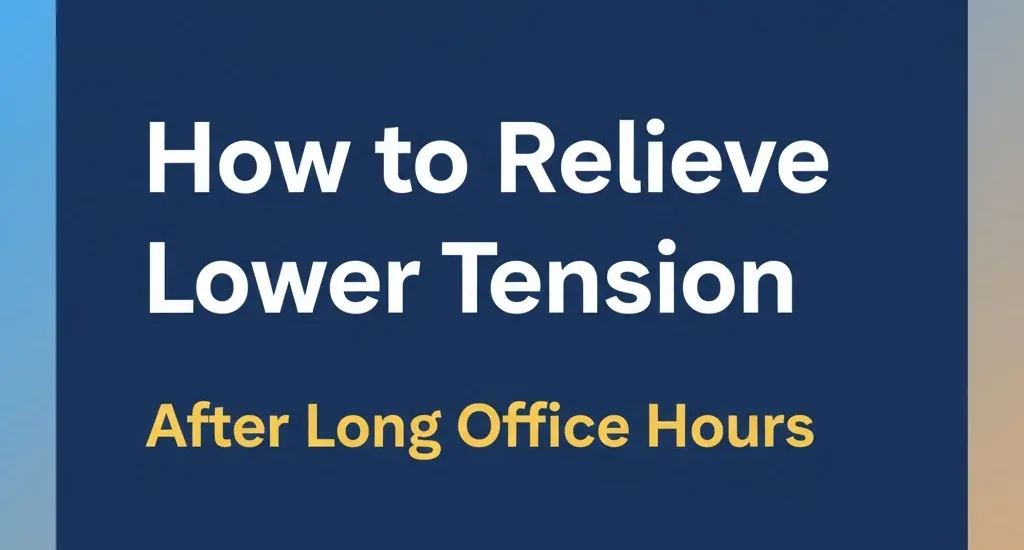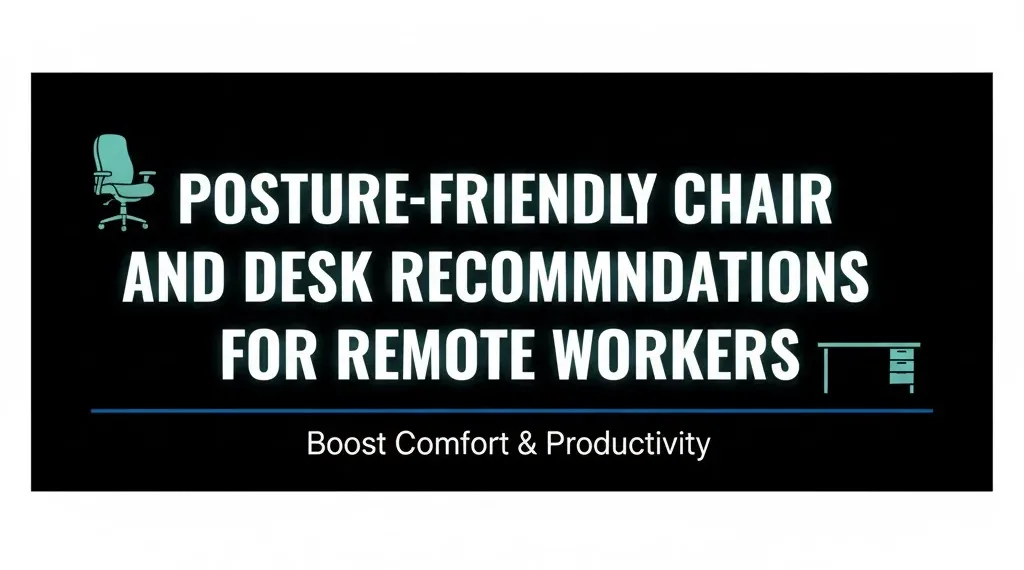Long office hours can cause stiffness, discomfort, and pain in the lower back. Sitting for extended periods without proper posture or breaks increases muscle strain and spinal pressure. Over time, this tension can lead to fatigue, reduced mobility, and even chronic back pain. The good news is that simple daily habits, targeted stretches, and posture awareness can ease tension and strengthen your back. This guide explains practical, science-backed methods on how to relieve lower back tension after long office hours effectively and naturally.
How Sitting Affects Your Lower Back
Sitting for long hours causes your hip flexors to tighten and gluteal muscles to weaken. This imbalance pulls on your lower spine, increasing tension and discomfort. Over time, poor sitting posture can lead to misalignment and reduced flexibility. Understanding this connection helps you identify where to make changes for immediate relief.
Common Causes of Lower Back Tension After Office Hours
-
Poor posture while sitting
-
Inadequate lumbar support
-
Weak core and glute muscles
-
Lack of movement throughout the day
-
Stress and muscle fatigue
-
Incorrect desk or chair height
Key Risk Factors for Lower Back Tension
| Risk Factor | Effect on Lower Back | Prevention Method |
|---|---|---|
| Slouching posture | Muscle strain and spinal misalignment | Sit upright with back supported |
| Inactive muscles | Reduced circulation and tightness | Stretch and move every hour |
| Poor chair ergonomics | Uneven spine pressure | Use ergonomic office chair |
| Stress | Muscle contraction | Practice deep breathing |
Best Ways to Relieve Lower Back Tension After Long Office Hours
1. Stretch Regularly
Stretching reduces stiffness and increases blood flow to the muscles. Simple movements can ease tension quickly.
Effective stretches include:
-
Cat-Cow stretch for spine flexibility
-
Child’s pose for gentle release
-
Standing hamstring stretch to loosen tight legs
-
Seated spinal twist for mobility
Perform these stretches for 5 to 10 minutes after work or during short breaks to prevent long-term stiffness.
2. Practice Proper Posture
Maintaining correct posture is vital. Keep your back straight, shoulders relaxed, and feet flat on the floor. Your screen should be at eye level to prevent slouching. A small cushion or lumbar roll behind your lower back can improve alignment and support.
3. Strengthen Your Core Muscles
A strong core supports the lower back and prevents tension buildup. Incorporate exercises like planks, bridges, and leg raises into your routine. Aim for 10–15 minutes daily to strengthen the muscles around your spine.
4. Adjust Your Workstation Ergonomically
Your chair, desk, and monitor setup affect back health more than you realize. An ergonomic setup reduces unnecessary strain.
Ideal Ergonomic Setup for Office Workers
| Component | Correct Position | Benefit |
|---|---|---|
| Chair | Adjustable with lumbar support | Supports spine and reduces tension |
| Monitor | At eye level | Prevents neck and shoulder strain |
| Keyboard | Slightly below elbow height | Keeps wrists neutral |
| Feet | Flat on the floor | Promotes proper alignment |
5. Use a Standing Desk
Alternating between sitting and standing reduces pressure on the lower back. A sit-stand desk allows you to move more, improving circulation and posture. Standing for at least 15 minutes every hour can significantly reduce discomfort.
6. Apply Heat or Cold Therapy
Heat therapy relaxes tight muscles and improves blood flow, while cold therapy reduces inflammation. Use a heating pad for 15–20 minutes or apply an ice pack for 10 minutes when pain flares up.
7. Take Short Walks During Breaks
Movement is the most effective natural remedy. Take a short walk every hour to loosen muscles and increase blood flow. Even a quick stretch beside your desk helps counteract stiffness.
8. Stay Hydrated Throughout the Day
Dehydration reduces muscle elasticity, leading to tightness. Drinking enough water ensures your muscles stay flexible and joints remain lubricated. Aim for 2–3 liters daily for optimal recovery and energy levels.
9. Improve Sleep Posture
A poor sleeping position can worsen back tension. Sleep on your back or side with a pillow between your knees to maintain spinal alignment. Choose a medium-firm mattress for consistent support.
10. Manage Stress
Tension in the lower back often increases with emotional stress. Techniques like meditation, controlled breathing, and mindfulness can relax both your mind and body.
Simple Relaxation Techniques for Back Health
| Technique | Duration | Benefit |
|---|---|---|
| Deep breathing | 5 minutes | Calms muscles and lowers stress |
| Meditation | 10 minutes | Improves focus and relaxation |
| Yoga | 15 minutes | Enhances flexibility and strength |
Quick Daily Routine to Relieve Lower Back Tension
-
Morning: 5-minute stretching routine
-
During work: Take a standing break every hour
-
After lunch: Short walk to relax muscles
-
Evening: Light core exercises and yoga poses
-
Before bed: Heat therapy and deep breathing
Foods That Help Reduce Inflammation and Muscle Tension
-
Fatty fish like salmon and tuna for omega-3s
-
Leafy greens such as spinach and kale
-
Turmeric and ginger for anti-inflammatory effects
-
Nuts and seeds for magnesium and muscle support
-
Berries and citrus fruits for antioxidants
Essential Tips for Office Workers
-
Keep your monitor directly in front of you
-
Avoid crossing your legs for long periods
-
Use a footrest if your chair is too high
-
Adjust armrests to prevent shoulder tension
-
Schedule periodic stretching reminders on your device
Benefits of Following a Consistent Back Care Routine
-
Reduced muscle stiffness and pain
-
Improved flexibility and range of motion
-
Enhanced focus and productivity at work
-
Lower risk of chronic back issues
-
Better posture and energy levels
When to See a Professional
If your pain persists despite stretching and posture corrections, consult a physiotherapist or orthopedic specialist. They can assess muscle imbalances and provide personalized exercises. Persistent numbness, shooting pain, or weakness in legs may require immediate attention.
Preventive Measures for Long-Term Back Health
-
Invest in ergonomic office furniture
-
Maintain an active lifestyle with regular walks or workouts
-
Strengthen your back and core through targeted training
-
Avoid sitting continuously for more than 45–60 minutes
-
Practice stress management to prevent muscle tightness
Simple Exercises You Can Do at Your Desk
-
Shoulder rolls: 10 repetitions to ease upper tension
-
Seated leg raises: Strengthen core and thigh muscles
-
Neck rotations: Relieve stiffness from screen time
-
Seated cat-cow: Stretch the spine gently
-
Forward bend: Improve blood circulation
Lifestyle Changes to Support Lower Back Health
-
Incorporate yoga or pilates twice weekly
-
Use a cushion to maintain lumbar curve
-
Avoid soft, sagging chairs
-
Keep your computer bag lightweight and balanced
-
Practice mindful sitting and movement habits
Ergonomic Checklist for Workstation Setup
-
Chair height allows elbows to form a 90-degree angle
-
Monitor top at or slightly below eye level
-
Keyboard positioned for relaxed wrist posture
-
Adequate lower back support from chair cushion
-
Feet rest flat or on a stable footrest
How to Relieve Lower Back Tension After Long Office Hours: Summary of Key Points
-
Move every hour to reduce stiffness
-
Stretch and strengthen your core daily
-
Maintain proper posture while sitting and sleeping
-
Use heat or cold therapy for temporary relief
-
Stay hydrated and manage stress effectively
-
Invest in an ergonomic setup for long-term comfort
FAQs
How can I relieve lower back tension fast?
Do light stretches and apply heat for quick muscle relaxation.
-
What posture prevents lower back pain while sitting?
Keep your back straight, shoulders relaxed, and feet flat. -
Is walking good for lower back tension?
Yes, walking improves circulation and reduces stiffness. -
Can stress cause lower back pain?
Yes, stress tightens muscles and increases discomfort. -
How often should I stretch during office hours?
Every 60 minutes of sitting should be followed by brief stretching. -
What is the best chair for lower back support?
An ergonomic chair with adjustable lumbar support works best.
Conclusion
Relieving lower back tension after long office hours is achievable with consistent movement, proper posture, and an ergonomic setup. Regular stretching, core strengthening, hydration, and stress control significantly reduce discomfort and improve flexibility. A few minutes of daily care can protect your spine, enhance productivity, and prevent long-term back issues. Prioritize these habits for lasting relief and healthier office routines every day








